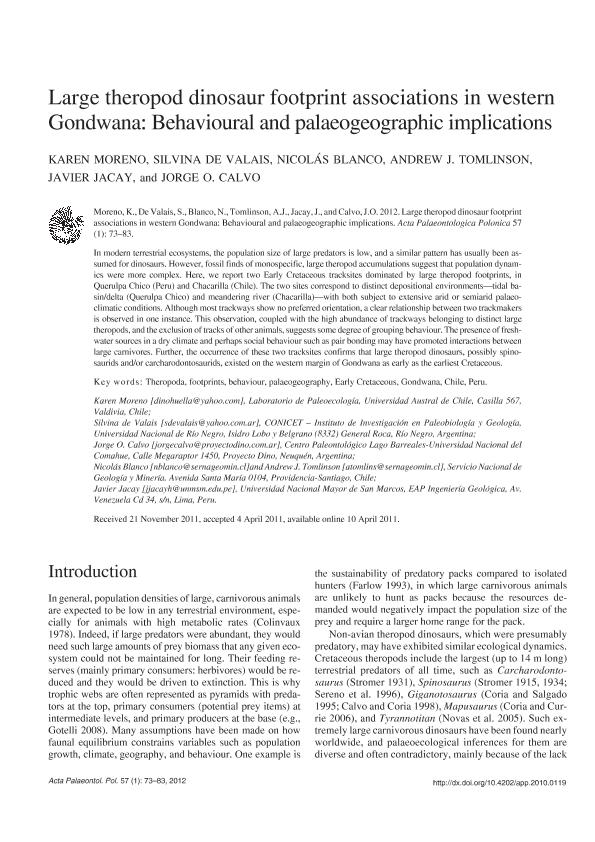Mostrar el registro sencillo del ítem
dc.contributor.author
Moreno, Karen
dc.contributor.author
de Valais, Silvina

dc.contributor.author
Blanco, Nicolás
dc.contributor.author
Tomlinson, Andrew J.
dc.contributor.author
Jacay, Javier
dc.contributor.author
Calvo, Jorge O.
dc.date.available
2023-04-24T14:46:29Z
dc.date.issued
2012-04
dc.identifier.citation
Moreno, Karen; de Valais, Silvina; Blanco, Nicolás; Tomlinson, Andrew J.; Jacay, Javier; et al.; Large theropod dinosaur footprint associations in western Gondwana: Behavioural and palaeogeographic implications; Polish Academy of Sciences. Institute of Paleobiology; Acta Palaeontologica Polonica; 57; 1; 4-2012; 73-83
dc.identifier.issn
0567-7920
dc.identifier.uri
http://hdl.handle.net/11336/195158
dc.description.abstract
In modern terrestrial ecosystems, the population size of large predators is low, and a similar pattern has usually been assumed for dinosaurs. However, fossil finds of monospecific, large theropod accumulations suggest that population dynamics were more complex. Here, we report two Early Cretaceous tracksites dominated by large theropod footprints, in Querulpa Chico (Peru) and Chacarilla (Chile). The two sites correspond to distinct depositional environmentstidal basin/delta (Querulpa Chico) and meandering river (Chacarilla)-with both subject to extensive arid or semiarid palaeoclimatic conditions. Although most trackways show no preferred orientation, a clear relationship between two trackmakers is observed in one instance. This observation, coupled with the high abundance of trackways belonging to distinct large theropods, and the exclusion of tracks of other animals, suggests some degree of grouping behaviour. The presence of freshwater sources in a dry climate and perhaps social behaviour such as pair bonding may have promoted interactions between large carnivores. Further, the occurrence of these two tracksites confirms that large theropod dinosaurs, possibly spinosaurids and/or carcharodontosaurids, existed on the western margin of Gondwana as early as the earliest Cretaceous.
dc.format
application/pdf
dc.language.iso
eng
dc.publisher
Polish Academy of Sciences. Institute of Paleobiology

dc.rights
info:eu-repo/semantics/openAccess
dc.rights.uri
https://creativecommons.org/licenses/by-nc-sa/2.5/ar/
dc.subject
BEHAVIOUR
dc.subject
CHILE
dc.subject
EARLY CRETACEOUS
dc.subject
FOOTPRINTS
dc.subject
GONDWANA
dc.subject
PALAEOGEOGRAPHY
dc.subject
PERU
dc.subject
THEROPODA
dc.subject.classification
Paleontología

dc.subject.classification
Ciencias de la Tierra y relacionadas con el Medio Ambiente

dc.subject.classification
CIENCIAS NATURALES Y EXACTAS

dc.title
Large theropod dinosaur footprint associations in western Gondwana: Behavioural and palaeogeographic implications
dc.type
info:eu-repo/semantics/article
dc.type
info:ar-repo/semantics/artículo
dc.type
info:eu-repo/semantics/publishedVersion
dc.date.updated
2023-04-24T13:00:32Z
dc.identifier.eissn
1732-2421
dc.journal.volume
57
dc.journal.number
1
dc.journal.pagination
73-83
dc.journal.pais
Polonia

dc.journal.ciudad
Varsovia
dc.description.fil
Fil: Moreno, Karen. Universidad Austral de Chile; Chile
dc.description.fil
Fil: de Valais, Silvina. Consejo Nacional de Investigaciones Científicas y Técnicas; Argentina. Universidad Nacional de Río Negro; Argentina
dc.description.fil
Fil: Blanco, Nicolás. Servicio Nacional de Geologia y Mineria; Chile
dc.description.fil
Fil: Tomlinson, Andrew J.. Servicio Nacional de Geologia y Mineria; Chile
dc.description.fil
Fil: Jacay, Javier. Universidad Nacional Mayor de San Marcos; Perú
dc.description.fil
Fil: Calvo, Jorge O.. Universidad Nacional del Comahue; Argentina
dc.journal.title
Acta Palaeontologica Polonica

dc.relation.alternativeid
info:eu-repo/semantics/altIdentifier/doi/http://dx.doi.org/10.4202/app.2010.0119
Archivos asociados
